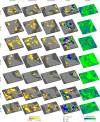Evaluating the Columnar Stability of Acoustic Processing in the Human Auditory Cortex
- PMID: 30185539
- PMCID: PMC6125808
- DOI: 10.1523/JNEUROSCI.3576-17.2018
Evaluating the Columnar Stability of Acoustic Processing in the Human Auditory Cortex
Abstract
Using ultra-high field fMRI, we explored the cortical depth-dependent stability of acoustic feature preference in human auditory cortex. We collected responses from human auditory cortex (subjects from either sex) to a large number of natural sounds at submillimeter spatial resolution, and observed that these responses were well explained by a model that assumes neuronal population tuning to frequency-specific spectrotemporal modulations. We observed a relatively stable (columnar) tuning to frequency and temporal modulations. However, spectral modulation tuning was variable throughout the cortical depth. This difference in columnar stability between feature maps could not be explained by a difference in map smoothness, as the preference along the cortical sheet varied in a similar manner for the different feature maps. Furthermore, tuning to all three features was more columnar in primary than nonprimary auditory cortex. The observed overall lack of overlapping columnar regions across acoustic feature maps suggests, especially for primary auditory cortex, a coding strategy in which across cortical depths tuning to some features is kept stable, whereas tuning to other features systematically varies.SIGNIFICANCE STATEMENT In the human auditory cortex, sound aspects are processed in large-scale maps. Invasive animal studies show that an additional processing organization may be implemented orthogonal to the cortical sheet (i.e., in the columnar direction), but it is unknown whether observed organizational principles apply to the human auditory cortex. Combining ultra-high field fMRI with natural sounds, we explore the columnar organization of various sound aspects. Our results suggest that the human auditory cortex contains a modular coding strategy, where, for each module, several sound aspects act as an anchor along which computations are performed while the processing of another sound aspect undergoes a transformation. This strategy may serve to optimally represent the content of our complex acoustic natural environment.
Keywords: auditory cortex; columnar processing; spectrotemporal modulations; tonotopy; ultra-high field fMRI.
Copyright © 2018 the authors 0270-6474/18/387822-11$15.00/0.
Figures







Similar articles
-
Frequency preference and attention effects across cortical depths in the human primary auditory cortex.Proc Natl Acad Sci U S A. 2015 Dec 29;112(52):16036-41. doi: 10.1073/pnas.1507552112. Epub 2015 Dec 14. Proc Natl Acad Sci U S A. 2015. PMID: 26668397 Free PMC article.
-
Distinct Representations of Tonotopy and Pitch in Human Auditory Cortex.J Neurosci. 2022 Jan 19;42(3):416-434. doi: 10.1523/JNEUROSCI.0960-21.2021. Epub 2021 Nov 19. J Neurosci. 2022. PMID: 34799415 Free PMC article.
-
Processing of natural sounds in human auditory cortex: tonotopy, spectral tuning, and relation to voice sensitivity.J Neurosci. 2012 Oct 10;32(41):14205-16. doi: 10.1523/JNEUROSCI.1388-12.2012. J Neurosci. 2012. PMID: 23055490 Free PMC article.
-
Stimulus-dependent activations and attention-related modulations in the auditory cortex: a meta-analysis of fMRI studies.Hear Res. 2014 Jan;307:29-41. doi: 10.1016/j.heares.2013.08.001. Epub 2013 Aug 11. Hear Res. 2014. PMID: 23938208 Review.
-
Using high spatial resolution fMRI to understand representation in the auditory network.Prog Neurobiol. 2021 Dec;207:101887. doi: 10.1016/j.pneurobio.2020.101887. Epub 2020 Aug 1. Prog Neurobiol. 2021. PMID: 32745500 Free PMC article. Review.
Cited by
-
Selective attention sharpens population receptive fields in human auditory cortex.Cereb Cortex. 2023 Apr 25;33(9):5395-5408. doi: 10.1093/cercor/bhac427. Cereb Cortex. 2023. PMID: 36336333 Free PMC article.
-
Processing complexity increases in superficial layers of human primary auditory cortex.Sci Rep. 2019 Apr 2;9(1):5502. doi: 10.1038/s41598-019-41965-w. Sci Rep. 2019. PMID: 30940888 Free PMC article.
-
Forging a path to mesoscopic imaging success with ultra-high field functional magnetic resonance imaging.Philos Trans R Soc Lond B Biol Sci. 2021 Jan 4;376(1815):20200040. doi: 10.1098/rstb.2020.0040. Epub 2020 Nov 16. Philos Trans R Soc Lond B Biol Sci. 2021. PMID: 33190599 Free PMC article. Review.
-
Dual Representation of the Auditory Space.Brain Sci. 2024 May 24;14(6):535. doi: 10.3390/brainsci14060535. Brain Sci. 2024. PMID: 38928534 Free PMC article. Review.
-
Functional organization of mouse primary auditory cortex in adult C57BL/6 and F1 (CBAxC57) mice.Sci Rep. 2020 Jul 2;10(1):10905. doi: 10.1038/s41598-020-67819-4. Sci Rep. 2020. PMID: 32616766 Free PMC article.
References
Publication types
MeSH terms
Grants and funding
LinkOut - more resources
Full Text Sources
Other Literature Sources
